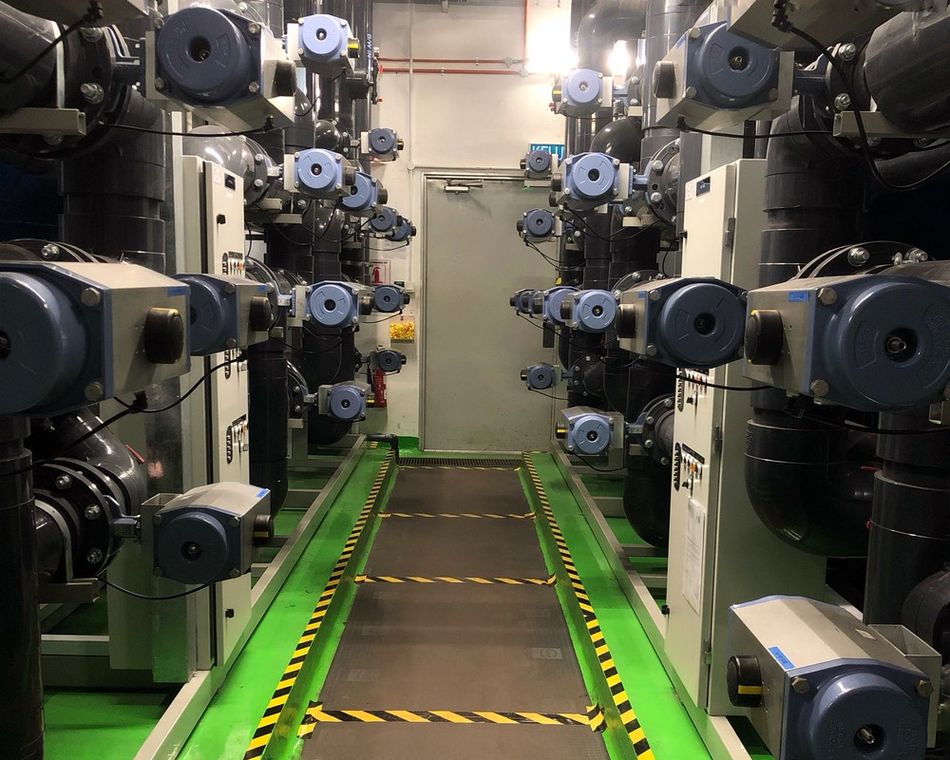Building Management: The Power of Building Automation Systems
Harnessing cutting-edge technology to optimize energy efficiency, comfort, and security in modern buildings

Introduction
Modern building management is undergoing a remarkable evolution through the adoption of Building Automation Systems (BAS). These systems integrate advanced sensors, controllers, and software to streamline crucial functions like HVAC, lighting, and security. By leveraging real-time data and sophisticated algorithms, BAS optimize energy efficiency, occupant comfort, and operational cost-effectiveness. Continuously monitoring and adjusting building parameters, BAS empower facility managers to uphold optimal conditions while curbing energy waste. In response to the rising demand for sustainable and intelligent buildings, BAS have emerged as essential tools for creating high-performance, eco-friendly, and user-centric environments.
Understanding the Fundamentals of Building Automation
Building automation systems (BAS) rely on a complex network of sensors, controllers, and communication protocols to optimize building performance. Sensors, the eyes and ears of BAS, continuously monitor environmental parameters such as temperature, humidity, occupancy, and light levels. These sensors, which can be wired or wireless, are strategically placed throughout the building to ensure comprehensive coverage. Common sensor types include thermistors, resistance temperature detectors (RTDs), humidity sensors, passive infrared (PIR) occupancy sensors, and photosensors, each with specific accuracy, range, and response time characteristics.
Controllers, the brains of BAS, process sensor data and make intelligent decisions based on predefined rules and algorithms. These controllers can be centralized or distributed, depending on the building's size and complexity. Centralized controllers are ideal for smaller buildings, while distributed controllers are more suitable for larger, multi-zone facilities. Controllers employ various control strategies, such as proportional-integral-derivative (PID) control, to maintain desired setpoints and optimize system performance. The choice of controller architecture and control strategy depends on factors such as the building's layout, HVAC system design, and energy efficiency goals.
Communication protocols, such as BACnet, LonWorks, and Modbus, facilitate seamless data exchange among BAS devices. Each protocol offers unique advantages in speed, reliability, and compatibility.
From pneumatic controls to digital systems and standardized protocols like BACnet and LonWorks, BAS have evolved to meet changing needs. IoT, cloud computing, and machine learning enable real-time analysis and system optimization, enhancing energy efficiency and sustainability.
Key Components of a BAS
 Modbus components on circuit board
Modbus components on circuit board
The main hardware and software components of a building automation system (BAS) include:
Sensors:
Temperature sensors, such as thermistors and RTDs, measure the temperature of air, water, or surfaces with an accuracy of ±0.1°C to ±1°C and a range of -50°C to 150°C.
Humidity sensors, including capacitive and resistive types, measure the relative humidity of air with an accuracy of ±2% to ±5% RH and a range of 0% to 100% RH.
Occupancy sensors, like PIR and ultrasonic sensors, detect the presence of people in a space, covering areas up to 2,000 sq. ft. and detecting motion up to 30 feet away.
Actuators:
Valves, such as ball and butterfly valves, control the flow of water or steam in HVAC systems, with a response time of 1-2 seconds and the ability to handle pressures up to 400 psi.
Dampers, including blade and louver types, control the flow of air in ducts, with a response time of 2-5 seconds and the capacity to handle air velocities up to 3,000 fpm.
Controllers:
Programmable Logic Controllers (PLCs), digital computers used for automation of electromechanical processes, have a processing speed of 1-100 MHz and can handle up to 1024 I/O points.
Direct Digital Controllers (DDCs), microprocessor-based devices used for control of HVAC systems, have a processing speed of 10-100 MHz and can handle up to 256 I/O points.
Software:
Building Management System (BMS) software provides a centralized platform for monitoring and controlling the BAS, offering features such as data visualization, alarm management, and energy reporting.
Supervisory Control and Data Acquisition (SCADA) software enables real-time monitoring and control of the BAS, with capabilities like data logging, trend analysis, and remote access.
Communication Protocols in BAS
Communication protocols are the backbone of building automation systems (BAS), enabling seamless data exchange and interoperability between various components and subsystems. These protocols define the rules, formats, and standards for transmitting data over communication networks, ensuring that devices from different manufacturers can communicate effectively.
Three of the most common communication protocols used in BAS are:
BACnet (Building Automation and Control Networks):
An open, standard protocol developed by ASHRAE for building automation applications
Supports multiple physical layers (Ethernet, RS-485, LonTalk) and provides a wide range of services (device/object discovery, data sharing, alarm management)
Offers flexibility and scalability for small to large-scale BAS implementations
LonWorks:
A proprietary protocol developed by Echelon Corporation, now managed by the LonMark International association
Uses a dedicated communication chip (Neuron Chip) and supports various physical media (twisted-pair, power line, fiber optics)
Provides a robust, reliable communication infrastructure with built-in error checking and recovery mechanisms
Offers a decentralized architecture for direct device-to-device communication
Modbus:
A simple, open-source protocol originally developed by Modicon (now Schneider Electric) for industrial automation
Supports serial (RS-232, RS-485) and Ethernet (Modbus TCP/IP) communication
Uses a master-slave architecture for data exchange between devices
Widely used in BAS for interfacing with HVAC equipment, meters, and sensors
Protocol | Key Features | Data Rates | Application Areas |
BACnet | Open, standard, flexible | 9.6 kbps - 100 Mbps | HVAC, lighting, access control |
LonWorks | Robust, reliable, decentralized | 78 kbps - 1.25 Mbps | HVAC, lighting, energy management |
Modbus | Simple, open-source, widely used | 9.6 kbps - 10 Mbps | HVAC, metering, sensors |
These protocols enable interoperability by providing a common language for devices to communicate, regardless of their manufacturer or specific functionality. For instance, a BACnet-compatible HVAC controller can exchange data with a BACnet-compatible lighting controller, allowing for integrated control strategies and energy optimization. Protocol implementation in BAS networks involves selecting appropriate network topologies (star, bus, tree), wiring media (twisted-pair cables, fiber optics, wireless), and configuration settings (device addresses, communication parameters, data points) to establish proper communication between devices. The choice of topology, media, and settings depends on the specific requirements and constraints of the building, such as the size, layout, and functionality of the BAS.
Cutting-Edge Advancements in BAS Technology
Building automation systems (BAS) have seen remarkable advancements recently, integrating cutting-edge technologies like Internet of Things (IoT), machine learning, and predictive maintenance. Through IoT, BAS now harness extensive networks of sensors for real-time monitoring and control, adjusting factors such as lighting and HVAC based on occupancy levels. This integration enhances energy efficiency and occupant comfort. Meanwhile, machine learning algorithms analyze data to forecast energy demand, detect equipment faults, and optimize maintenance schedules, thereby reducing downtime and prolonging equipment lifespan.
The synergy of IoT and machine learning enables predictive maintenance, foreseeing and mitigating potential equipment failures. This integration relies on cloud-based data storage for IoT data and machine learning model training. Additionally, open APIs facilitate seamless communication between BAS and external systems, enabling customized applications and dashboards for data visualization and control. This holistic approach to building management optimizes overall performance by combining insights from various systems to enhance efficiency and sustainability.
IoT Integration in BAS
The Internet of Things (IoT) is revolutionizing building automation systems (BAS) by enabling the integration of smart sensors, gateways, and other connected devices. IoT devices in BAS can include a wide range of sensors, such as temperature, humidity, occupancy, and air quality sensors, as well as actuators and controllers for HVAC, lighting, and security systems. These devices communicate using lightweight, efficient IoT protocols like MQTT (Message Queuing Telemetry Transport) and CoAP (Constrained Application Protocol), which are designed for resource-constrained environments.
IoT gateways bridge the gap between IoT devices and cloud-based platforms in BAS. They aggregate data from multiple sensors, perform edge processing and filtering, and securely transmit the data to IoT platforms like AWS IoT or Microsoft Azure IoT. These platforms provide scalable and secure infrastructure for data storage, analysis, and visualization, enabling remote monitoring and control of BAS.
The benefits of IoT integration in BAS are numerous:
Remote monitoring: IoT-enabled BAS allows facility managers to monitor building performance and equipment status remotely, reducing the need for on-site inspections and enabling proactive maintenance.
Real-time data analysis: IoT platforms can process and analyze vast amounts of data generated by IoT devices in real time, providing actionable insights into building performance, energy consumption, and occupant behavior.
Enhanced automation: IoT devices can communicate with each other and with BAS control systems, enabling more granular and responsive automation strategies. For example, IoT occupancy sensors can trigger automatic adjustments to lighting and HVAC settings based on real-time occupancy data.
Smart lighting control exemplifies IoT in BAS. Sensors in lighting fixtures detect occupancy, light, and energy use, communicating with a central system via protocols like ZigBee or BLE. The system adjusts lighting based on occupancy, daylight, and energy goals. Implementation involves sensor setup, communication establishment, and automation logic definition.
The Edge Building in Amsterdam, Netherlands, serves as a successful example of IoT-based BAS implementation. Spanning 40,000 square meters, this office utilizes IoT to enhance energy efficiency, occupant comfort, and space usage. With over 28,000 sensors—tracking occupancy, temperature, humidity, CO2 levels, and smart meters—the BAS regulates HVAC and lighting. Data analysis occurs on a cloud platform, facilitating real-time insights and dynamic control. Ensuring interoperability among IoT devices posed a significant technical hurdle, addressed through open protocols, standardized data models, and custom middleware and APIs for seamless data exchange and control.
Machine Learning and Predictive Maintenance
Machine learning is revolutionizing building automation systems (BAS) by enabling the analysis of vast amounts of data generated by IoT devices and sensors to identify patterns, detect anomalies, and predict future trends. The application of machine learning in BAS involves several key steps:
Data preprocessing: Cleaning, transforming, and normalizing raw data from BAS sensors and devices, handling missing or inconsistent data, removing outliers, and scaling features to ensure similar ranges.
Feature selection: Identifying the most relevant variables or attributes that have the greatest impact on the target variable, such as energy consumption or equipment failure, to reduce data dimensionality and improve model efficiency and accuracy.
Model training: Applying machine learning algorithms to analyze data and build predictive models.
Two common types of algorithms in BAS are decision trees and neural networks. Decision trees use rules to make decisions based on factors influencing outcomes, while neural networks learn complex patterns for tasks like fault detection in HVAC systems. Predictive maintenance, a key application of machine learning in BAS, analyzes equipment performance data to predict failures. This allows proactive maintenance, minimizing downtime and optimizing scheduling based on factors like criticality and costs.
In a large commercial office building in Singapore, machine learning was used for predictive maintenance. With 1,500+ IoT sensors collecting data on equipment parameters, including air handling units and chillers, decision trees and neural networks analyzed this data. The result: failure prediction models continuously updated with new IoT sensor data, ensuring efficient maintenance practices.
Recommended Reading : https://www.wevolver.com/article/machine-learning-powered-home-scenes-a-blueprint-for-intelligent-home-automation
The implementation process involved several key steps:
Data collection: Installing IoT sensors on critical equipment and connecting them to a central data acquisition system.
Data preprocessing: Cleaning, transforming, and normalizing raw sensor data to ensure data quality and consistency.
Feature selection: Identifying the most relevant features for each type of equipment using statistical analysis and domain expertise.
Model development: Developing and training decision tree and neural network models using preprocessed data and selected features.
Model deployment: Integrating trained models into the building management system to generate real-time predictions and maintenance recommendations.
The predictive maintenance system yielded impressive results, including a 25% reduction in maintenance costs, a 30% reduction in unplanned downtime, and a 15% improvement in energy efficiency. These outcomes demonstrate the significant potential of machine learning in optimizing BAS performance, reducing operational costs, and enhancing overall building efficiency.
Overcoming Challenges and Considerations in BAS Implementation
Implementing building automation systems (BAS) in engineering projects comes with a range of challenges and considerations that must be addressed to ensure successful deployment and operation. Some of the key issues include cybersecurity risks, interoperability challenges, and the need for skilled personnel.
Cybersecurity is a critical concern in BAS implementation, as these systems are increasingly connected to the internet and other networks, making them potential targets for cyber attacks. BAS can be vulnerable to various threats, such as unauthorized access, data breaches, and malware infections, which can compromise the security and privacy of building data and control systems. To mitigate these risks, it is essential to implement robust cybersecurity measures, such as:
Encryption: Using strong encryption algorithms, such as Advanced Encryption Standard (AES) or Secure Sockets Layer/Transport Layer Security (SSL/TLS), to protect data in transit and at rest.
Authentication: Implementing secure authentication mechanisms, such as role-based access control (RBAC) and two-factor authentication (2FA), to ensure that only authorized users can access the BAS.
Network segmentation: Segregating the BAS network from other networks using virtual local area networks (VLANs) and firewalls to limit the potential impact of a security breach.
Interoperability is another significant challenge in BAS implementation, as these systems often involve integrating multiple devices, protocols, and subsystems from different vendors. Ensuring seamless communication and data exchange between these components can be complex and time-consuming. To address interoperability challenges, it is important to:
Adhere to industry standards: Following established standards, such as ASHRAE 135 (BACnet) and ISO 16484 (Building automation and control systems), to ensure compatibility and interoperability between BAS components.
Use open protocols: Adopting open communication protocols, such as BACnet and LonWorks, which have well-defined specifications and support a wide range of devices and applications.
Implement integration strategies: Employing middleware solutions, gateways, and protocol converters to enable communication between disparate systems and protocols.
The successful implementation of BAS also requires skilled personnel with expertise in building automation, networking, and cybersecurity. However, finding and retaining qualified professionals can be challenging, particularly in a rapidly evolving technological landscape. To address this issue, organizations should:
Invest in training and certification programs: Providing ongoing training and support for BAS professionals to keep their skills up-to-date with the latest technologies and best practices.
Foster collaboration and knowledge sharing: Encouraging collaboration and knowledge sharing among BAS professionals through forums, workshops, and online communities.
Develop clear career paths: Establishing clear career paths and progression opportunities for BAS professionals to attract and retain talent in the field.
By addressing these challenges and considerations, organizations can ensure the successful implementation of BAS in engineering projects, realizing the full potential of these systems in terms of energy efficiency, occupant comfort, and operational optimization. This requires a proactive and holistic approach that encompasses robust cybersecurity measures, adherence to interoperability standards, and investment in skilled personnel.
Cybersecurity in BAS
 cybersecurity
cybersecurity
Cybersecurity is a critical aspect of building automation systems (BAS) that cannot be overlooked. As BAS become increasingly connected and integrated with other systems, they become more vulnerable to cyber threats. Potential vulnerabilities in BAS include:
Unsecured network ports: Open or poorly configured ports can allow unauthorized access to BAS networks.
Weak passwords: Easily guessable or default passwords can be exploited by attackers to gain access to BAS components.
Outdated software: BAS software with known security flaws can be targeted by attackers using malware, phishing, and social engineering tactics.
The risks associated with compromised BAS are significant and can have far-reaching consequences:
Data breaches: Exposing sensitive information, such as occupant data, energy consumption patterns, and system configurations, leading to privacy violations and reputational damage.
System hijacking: Allowing attackers to take control of BAS components, such as HVAC units, lighting systems, and access control devices, potentially causing physical damage or disrupting building operations.
Denial-of-service attacks: Overwhelming BAS networks with traffic, rendering them unavailable and impacting critical building functions.
To mitigate these risks, it is essential to implement best practices for securing BAS networks:
Network segmentation: Dividing the BAS network into smaller, isolated subnetworks using VLANs and firewalls to limit the spread of potential attacks.
Secure network protocols: Using secure communication protocols, such as BACnet/SC (Secure Connect) or SSL/TLS, to encrypt data transmission and protect against eavesdropping and tampering.
Strong access control: Implementing robust user authentication mechanisms, such as multi-factor authentication and role-based access control, to ensure that only authorized personnel can access BAS resources.
Regular software updates: Keeping BAS software and firmware up-to-date with the latest security patches and updates to address known vulnerabilities.
Continuous monitoring: Deploying intrusion detection systems (IDS) and security information and event management (SIEM) tools to monitor BAS networks for suspicious activities and potential threats.
A notable case study of a BAS cybersecurity incident occurred at the Target Corporation in 2013. Attackers gained access to Target's network through a vulnerability in the company's HVAC system, managed by a third-party vendor. The attackers used this initial access to pivot into Target's payment systems, stealing the credit card information of over 40 million customers. The breach was facilitated by several technical factors:
Weak access controls: Inadequate authentication mechanisms for vendor accounts allowed attackers to gain unauthorized access to Target's network.
Lack of network segmentation: The HVAC system was not properly isolated from other parts of the network, enabling the attackers to move laterally and reach sensitive systems.
Inadequate monitoring: Target's security monitoring tools failed to detect the suspicious activity in a timely manner, allowing the breach to go unnoticed for an extended period.
The impact of the Target breach was significant, resulting in financial losses exceeding $200 million, reputational damage, and legal consequences. In response, Target implemented several remediation measures:
Strengthening access controls: Implementing two-factor authentication for vendor accounts and restricting access to sensitive systems.
Enhancing network segmentation: Isolating the HVAC system from other parts of the network to limit the potential impact of future breaches.
Improving monitoring: Deploying advanced threat detection and monitoring tools to identify and respond to potential security incidents more quickly.
Recommended Reading : https://www.wevolver.com/article/smart-home-security-security-and-vulnerabilities
Conclusion
Building automation systems (BAS) are crucial for optimizing building performance, energy efficiency, and occupant comfort. This article explores BAS components like sensors, actuators, controllers, and communication protocols, emphasizing their technical aspects and performance metrics. Leveraging IoT, machine learning, and predictive maintenance, BAS enables real-time monitoring, data-driven optimization, and proactive fault detection.
BAS holds immense potential in driving sustainability, with studies indicating energy savings of 10-30% in commercial buildings. Real-world cases, like the Empire State Building retrofit project, underscore BAS's tangible impact on efficiency and carbon emission reduction.
The future of BAS looks promising, with AI-driven optimization and blockchain-based security on the horizon. Engineers play a critical role in shaping this future, staying updated on BAS advancements and developing skills to design, implement, and maintain these systems. The future of building automation is bright, with engineers leading the way in creating sustainable, intelligent buildings.
Frequently Asked Questions
What are the key components of a Building Automation System (BAS), and how do they work together to optimize building performance?
- BAS components include sensors, controllers, actuators, and communication protocols. They collaborate to monitor environmental parameters, process data, and adjust system settings for optimal building performance.
How does the integration of IoT, machine learning, and predictive maintenance enhance the capabilities of BAS in modern buildings?
- Integration of IoT enables real-time monitoring, machine learning optimizes system performance, and predictive maintenance minimizes downtime, enhancing energy efficiency and occupant comfort.
What are some common challenges and considerations in the implementation of BAS, particularly concerning cybersecurity and interoperability?
- Challenges include cybersecurity risks, interoperability issues, and the need for skilled personnel. Addressing these challenges requires robust cybersecurity measures, adherence to interoperability standards, and investment in trained professionals.
Can you provide examples of real-world applications of BAS, such as energy savings achieved in commercial buildings or successful retrofit projects?
- Real-world applications include energy savings of 10-30% in commercial buildings and successful retrofit projects like the Empire State Building. BAS optimize efficiency by continuously monitoring and adjusting building parameters.
What are the essential factors to consider when selecting sensors for a BAS, and how do they contribute to monitoring and controlling building parameters effectively?
- Factors include sensor accuracy, range, resolution, stability, and environmental tolerance. Sensors provide accurate data on environmental parameters, enabling BAS to adjust system settings for optimal performance.
References:
[1] Building Automation Drives Greater Efficiency and Occupant Comfort
[2] Building automation by CISCO
[3] Building AI-driven closed-loop automation systems - IBM
Table of Contents
IntroductionUnderstanding the Fundamentals of Building AutomationKey Components of a BASModbus components on circuit boardCutting-Edge Advancements in BAS TechnologyIoT Integration in BASMachine Learning and Predictive MaintenanceOvercoming Challenges and Considerations in BAS ImplementationCybersecurity in BAScybersecurityConclusionFrequently Asked QuestionsReferences: